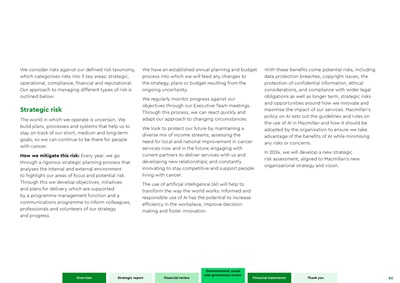
We consider risks against our defined risk taxonomy,
which categorises risks into 5 key areas: strategic,
operational, compliance, financial and reputational.
Our approach to managing different types of risk is
outlined below:
Strategic risk
The world in which we operate is uncertain. We
build plans, processes and systems that help us to
stay on track of our short, medium and long-term
goals, so we can continue to be there for people
with cancer.
How we mitigate this risk: Every year, we go
through a rigorous strategic planning process that
analyses the internal and external environment
to highlight our areas of focus and potential risk.
Through this we develop objectives, initiatives
and plans for delivery which are supported
by a programme management function and a
communications programme to inform colleagues,
professionals and volunteers of our strategy
and progress.
We have an established annual planning and budget
process into which we will feed any changes to
the strategy, plans or budget resulting from the
ongoing uncertainty.
We regularly monitor progress against our
objectives through our Executive Team meetings.
Through this process, we can react quickly and
adapt our approach to changing circumstances.
We look to protect our future by maintaining a
diverse mix of income streams; assessing the
need for local and national improvement in cancer
services now and in the future; engaging with
current partners to deliver services with us and
developing new relationships; and constantly
innovating to stay competitive and support people
living with cancer.
The use of artificial intelligence (AI) will help to
transform the way the world works. Informed and
responsible use of AI has the potential to increase
efficiency in the workplace, improve decisionmaking
and foster innovation.
With these benefits come potential risks, including
data protection breaches, copyright issues, the
protection of confidential information, ethical
considerations, and compliance with wider legal
obligations as well as longer term, strategic risks
and opportunities around how we innovate and
maximise the impact of our services. Macmillan's
policy on AI sets out the guidelines and rules on
the use of AI in Macmillan and how it should be
adopted by the organisation to ensure we take
advantage of the benefits of AI while minimising
any risks or concerns.
In 2024, we will develop a new strategic
risk assessment, aligned to Macmillan's new
organisational strategy and vision.
80
Environmental, social
and governance review
Financial review
Strategic report
Overview Financial statements Thank you